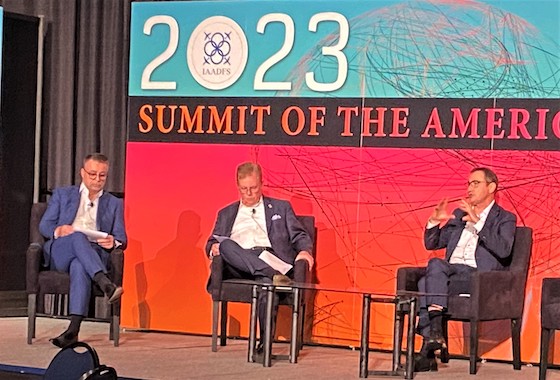
In one of the critical information sessions held during the Summit of the Americas in April, two influential regional aviation leaders shared their insights on the dynamics and changing developments facing airports across North America, Mexico, Central and South America and the Caribbean.
Kevin Burke, President and CEO of Airports Council International – North America, and Rafael Echevarne, Director General of Airports Council International – Latin America and the Caribbean, discussed a range of topics including how infrastructure demands, labor challenges, security requirements, and regulatory hurdles are being addressed to help advance the airport concessions business.
The session was moderated by Rene Riedi in his role as Chair of the International Association of Airport & Duty Free Stores, starting from the premise that duty free and travel retail concessions are crucial to the airports’ success.
Both Burke and Echevarne agreed that duty free concessions are an essential part of the airport business model in this part of the world, which has seen some of the best air travel recovery since the pandemic.
Burke, discussing how the entire U.S. air system was essentially shut down on April 20, 202, said: “Fast forward to today and we have almost recovered.”
Echevarne agreed about the “spectacular” aviation recovery in Latin America and the Caribbean, which closed last year at 7% below 2019 figures. He highlighted Mexico, where most of the airports are run by the private sector, and some of which are currently 25% above 2019 levels.
Echevarne is very positive about the potential for retail and duty free. Explaining that most Latin American airports are at levels below the world average in terms of sales per passenger and penetration (and were at lower levels even before the pandemic struck), he said: “I think there’s a huge potential for the industry in Latin America.”
One reason why Latin America air traffic is recovering so fast was that the region was isolated from some international and global trends, he noted.
“Asian traffic in Latin America is practically non-existent. We have no flights to China, so we are very much sheltered from whatever was happening in Asia.”
On the other hand, Latin America has “an incredible air network with the U.S. and Canada. The flows are tremendous and traffic flows keep on going up.”
In North America on the other hand, air traffic is 9% below the 2019 levels, with “the big hit” coming from the lack of international traffic, particularly from Asia, at both the East and West coast airports in the U.S. and Canada, said Burke.
“This was a severe decrease from that part of the world but we are seeing almost a total recovery by 2024,” he said.
“If the numbers that we see coming through the summer are what they are supposed to be, we should be doing fine. What happens in the fall and beyond that, we’re not quite sure. But compared to where we were in 2021, when the industry was at rock bottom, we went up pretty quickly.”
Rene Riedi, reiterating his opening remarks, said that up to 44% of airports’ revenue are coming from non-aeronautical sources, and retail concessions contribute 30% of this figure.
“How important is duty free revenues to the airport’s bottom line?” he asked.
“They are absolutely essential in Latin America, and that’s why I was saying that the potential is huge,” responded Echevarne.
“In Latin America, only 28% of the revenue comes from non-aeronautical activities, and duty free is probably the majority of this. That’s why I say very firmly that the potential is tremendous to increase non-aeronautical activities. Duty free, as a percentage of non-aeronautical revenue, is more important than in the U.S.–it is about 50%, so the bottom line of the airport operators in Latin America depends absolutely on the performance of retail,” he said.
Echevarne added: “The majority of airports in Latin America are actually run by private companies through concessions. And that is very important, because they are very much aware of the importance of the bottom line, and the importance of retail.”
The situation in North America is nearly the exact opposite of that in Latin America, said Burke.
“The majority of the airports in the United States are owned by a city government or state government, and authorities, and they are very challenging. But revenues is a key component to the success of any business,” he said.
Breaking down the revenue stream in North American airports, Burke reported that aeronautical revenue accounts for about 49%; non-aeronautical and commercial revenue is about 25%. And non-operating, or grants from the federal government, accounts for 26%. Among the non-aeronautical revenue, Burke said that car parking is number one at 37%, rental car concessions account for 21%, food and beverage generate 7%, and retail concessions bring in 5%.
“Which is very different for [us in Latin America],” said Eschevarne. “In our case, retail concessions generate 26%.”
Discussing the disparity between the duty free and travel retail revenues between North and South America, Burke analyzed it as due to a mixture of reasons: the popularity of big box retailers and discount liquor and wine stores eliminate the need to purchase those things in an airport duty free store in the U.S.
Regulatory hurdles, like gate delivery also limit airport sales, Burke agreed, as does the time needed to get through security.
“Worrying about whether you will make your gate on time, to some degree, inhibits the purchase of concession products, whether it be a newspaper from Hudson or a meal in one of our restaurants.”
He adds “you go through multiple steps before you actually get to the duty free shop. And once you buy an item, can you take it with you or does it have to be delivered to you at the gate, which is an inconvenience as well.
“So I think it’s a cultural difference as to why people don’t buy at duty free as much as they do in other regions in the world. I would love to see that number go up but I think certain things have to change to make it easier for the customer. I think the rules and regulations in the U.S. sometimes inhibit that growth.”
Buying duty free in Latin America is much more along the lines of the rest of the world, Europe, Asia and so on, said Echevarne.
“That is part of the experience of traveling internationally, to buy in the duty free shop. Also, in Brazil, you can actually buy duty free upon arrivals. And as you well know, in Brazil, the sales generated in arrivals is more important than at departures, which is very sweet for us.
“Of course, we also face the issue of the security lines, and then the passport lines. But we are working very seriously to eliminate those lines to reduce them as much as possible in the region,” he said.
Echevarne is also very enthusiastic about the potential of technology to improve the airport travel experience.
“We had a very good session a few weeks ago in Costa Rica, where the airport operator requested that we explain to the government the advantages of introducing technology to reduce security lines and passport runs with facial recognition technology. Because not only do we want to expedite the process, and maximize the use of the infrastructure, we want to provide a very pleasurable experience for the passengers. We also want to maximize the dwell time that is gained on the air side. All of these can be achieved through the use of technology,” said Echevarne.
Burke agreed that the biggest challenge to developing more nonaeronautical revenue in North American airports are the long lines that people have to endure to get through ticketing and security.
“The goal of this is to speed up the process by which passengers get on the plane. So by the time they get into the terminal, they are not all stressed out.
“… if we have the technology where people can get through the airport and on the plane safely, then the concession side of the airport –both duty free or just regular concessions– that number will go up. We’ll see a change as that technology gets better,” he said
The very structure of North American airports versus those in Latin America is also a factor in concession revenues, said the speakers.
According to Burke, the majority of airports in the United States and Canada are not considered international airports. Most international traffic goes through the large hubs, the coastal airports, the JFKs, Chicago, Atlanta, etc.
“But when it comes to the larger airports, we have an issue in the United States which I describe as: ‘we have a bunch of really great 20th century airports, but we have very few really good 21st century airports.’”
And most of these “20th century” airports were not planned with today’s concessions in mind, he said, and weren’t designed with space for a lot of things we need today.
While a number of new airports now going up in the U.S., such as Louis Armstrong in New Orleans, and Terminal C in Orlando, are taking a look at the longer picture and planning space for future needs, Burke says the way in which we finance airports in the United States makes it very difficult.
The bottom line is that U.S. airports need more money to modernize than they have.
“We need about $150 billion over the next five years to modernize our airports into the 21st century, which comes down to about $30 billion a year, and we’re only bringing in about half of that,” said Burke. “This means that the debt level carried by U.S. airports is about $114 billion right now. Our airports are not privatized, like those in Latin America are.”
“We have retailers that want to modernize their retail facilities, but we have a footprint that’s not modernized. And that’s the challenge. Where do we get more money to modernize? And unlike most of my colleagues around the world, our Congress determines how much money we get per passenger on a flight, and this determines the grant money to get from the FAA. Very few U.S. airports, I can look at LaGuardia, Newark, and one or two others, have been privatized. We are the laggards globally in terms of privatization. And that’s mostly a political problem.”
In Latin America, Echevarne admits that the major issue is capacity.
“The problem that we face in Latin America is, on the one hand, using technology to run the airports more efficiently. That’s why we are focusing so much on maximizing the infrastructure.
“And the other problem is that the contracts are extremely complex. The governments are very wary of allowing changes to be made to the concession contracts. In some airports in Latin America, you cannot move a wall an inch, and that contract was written 10 years ago. So much has changed since then.”
Looking ahead, Echevarne sees opportunities to introduce more professional management of airports.
“I think that there is a huge opportunity to really inject know how, but for that to happen, you also have to provide that flexibility I was referring to. Other than that it’s just letting the traffic flourish.”
Another objective is to liberalize air traffic agreements. “In our region we still operate in a very restrictive bilateral situation. We strongly believe that if traffic in Latin America were to liberalize and any airline could fly anywhere they wanted, the opportunity for growth would be fantastic.”









